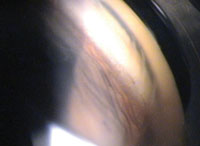
|

|

|
|
The surgeon uses a gonio lens to visualize the trabecular meshwork during SLT.
|
Despite this renaissance in glaucoma care, the role of patient compliance and adherence cannot be overlooked. Noncompliance and non-adherence rates, reported to be at least 25%, continue to undermine our best efforts. Common reasons include inconvenience, forgetfulness, cost and side effects of medications.
Burning Questions
Can laser trabeculoplasty match or beat the results of medical therapy, while also reducing the impact of noncompliance?
Argon laser trabeculoplasty (ALT), introduced in the 1970s, can lower IOP by about 25% to 30%. Though the exact mechanism still is not known, the laser energy may have multiple effects on the trabecular tissue, including a mechanical effect from scar formation at the burn sites and biologic changes in the trabecular endothelial cells.
ALT was evaluated in the NEI’s Glaucoma Laser Trial (GLT), which compared the procedure’s safety and long-term efficacy with that of standard medical therapy for primary open-angle glaucoma. Eyes treated initially with ALT had 1.2mm Hg greater IOP reduction, 0.6db greater visual field improvement and better optic disc status than fellow eyes treated initially with topical medication. Although this trial evaluated argon laser treatment, modern-day glaucoma laser surgery has largely migrated to selective laser trabeculoplasty (SLT) and micropulse laser trabeculoplasty due to their comparable IOP lowering efficacies, but with less damage/scarring and better repeatability.
SLT is an outpatient procedure, performed with a laser-equipped slit lamp. The energy is produced by a specially designed Q-switched, frequency-doubled Nd:YAG laser operating at a 532nm green wavelength, with a potential output of 0.3 to 1.5 millijoules.
Preoperatively, the patient is given one drop of either apraclonidine or brimonidine, plus topical anesthesia. A Goldmann, three-mirror gonio lens is placed on the eye with methylcellulose and the aiming beam is focused onto the pigmented trabecular meshwork. Next, the non-thermal laser is applied using short pulses of relatively low energy with a larger spot size to target and irradiate only the melanin-rich cells in the trabecular meshwork.
Treatment is done in single-burst mode, placing about 50 contiguous but not overlapping 400µm laser spots along 180 degrees. The principle of selective photothermolysis enables the laser to precisely target intracellular melanin granules to activate individual cells without disturbing adjacent non-pigmented cells. The activated cells release cytokines that trigger a targeted macrophage response to the trabecular meshwork cells. The macrophages reactivate the meshwork, reducing fluid outflow resistance and lowering intraocular pressure.
The procedure takes about five minutes per eye, is relatively painless and there are no restrictions afterwards. Postoperatively, patients are prescribed topical NSAIDs or steroids for one week. Clinical improvement may take one to three months to manifest.
Benefits of SLT include proven efficacy as primary, adjunctive or repeat therapy; lack of systemic side effects; protection of the trabecular meshwork; reduced drug costs and improved compliance. Potential side effects include post-op inflammation and IOP spike, which can be controlled with topical meds.

